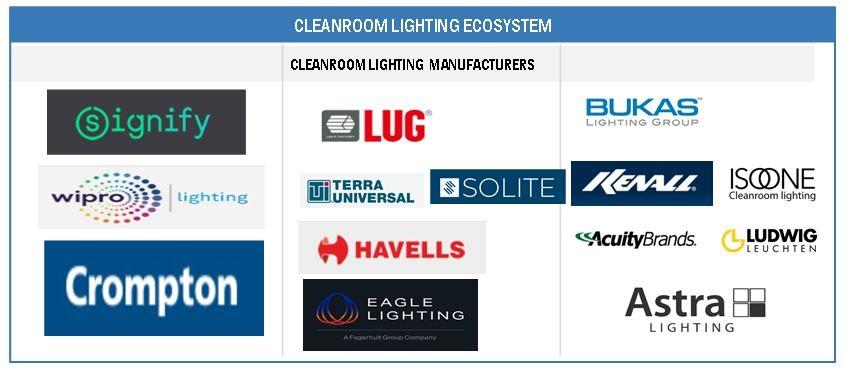The Cleanroom Lighting Market is projected to reach USD 1.1 billion by 2029 from USD 0.9 billion in 2024; it is expected to grow at a CAGR of 5.4% from 2024 to 2029.
The Cleanroom Lighting market is being propelled by several key factors, including increased demand for energy-efficient and sterile environments for pharmaceutical manufacturing, semiconductor manufacturing, food and beverage production and packaging as well as healthcare, which drives the growth for cleanroom lighting in these facilities.
Cleanroom Lighting Market Ecosystem
The prominent market players in the Cleanroom Lighting market include Signify Holding (Netherlands), Wipro Lighting (India), Crompton Greaves Consumer Electricals Limited (India), Acuity Brands, Inc. (US), Kenall Manufacturing (US), Terra Universal Inc. (US), Bukas Lighting Group (US), Solite Europe (England), LUG Light Factory Sp. z o.o. (Poland), Eagle Lighting Australia Pty Ltd (Australia).
Download PDF Brochure:
https://www.marketsandmarkets.com/pdfdownloadNew.asp?id=213070777
Cleanroom Lighting Market Dynamics:
Driver: Advancements in cleanroom lighting technology
Technological advancements in the cleanroom lighting industry are driving innovation, efficiency, and performance improvements. These advancements contribute to creating lighting solutions that meet the strict requirements of cleanroom environments. Some key technological trends in the cleanroom lighting industry are discussed here.
Light Light-emitting diode (LED) technology has become a cornerstone in cleanroom lighting. LEDs offer several advantages, including energy efficiency, longer lifespan, and reduced heat emission. The ability to provide precise and uniform illumination without generating excess heat makes LED lighting a preferred choice for cleanroom applications. For instance, Wipro Lighting, a part of Wipro conglomerate, offers clean room lighting solutions that use high-efficacy LEDs that save energy up to 55% and reduce the operational costs significantly. These solutions are Vision LED Prime TOCR, Vision LED, and Vision +. Thus, understanding the importance of incorporating LEDs in cleanroom lighting, companies are efficiently using them for better illumination results.
Restraint: Sustainability concerns in the cleanroom lighting industry
While the cleanroom lighting industry aims to create clean and controlled environments, some practices and technologies raise concerns about their environmental impact. Traditional cleanroom lighting often relies on fluorescent fixtures, which, while efficient compared to incandescent bulbs, still consume significant energy. The need for maintaining specific temperature and humidity levels in cleanrooms adds to the overall energy demands of the facility. Also, High-intensity UV-C LED disinfection systems, while effective, can also be energy-intensive, especially if not optimized.
Opportunity: Increasing adoption of sensors and automation in cleanroom lighting
The integration of sensors and automation in cleanroom lighting represents a growing trend that brings notable benefits to the operational dynamics of cleanroom environments. Sensors play a pivotal role in monitoring various environmental parameters within the cleanroom, such as temperature, humidity, particle levels, and light intensity. By continuously collecting real-time data, these sensors enable the automation system to adjust lighting conditions precisely in response to the specific needs of the environment. This dynamic control ensures that energy is utilized optimally, contributing to overall operational efficiency. Also, automation in cleanroom lighting allows for adaptive illumination based on the current conditions.
Challenge: Maintenance and cleaning challenges
Ensuring compliance with cleanliness standards in cleanroom environments necessitates regular maintenance of lighting fixtures. However, this process comes with several challenges, including cleaning procedures and the potential for disruptions to cleanroom operations.
Cleanroom lighting fixtures require meticulous cleaning procedures to eliminate any potential sources of contamination. The strict cleanliness standards demand thorough cleaning, often involving specialized cleaning agents and protocols to maintain the sterile environment. While cleaning fixtures, there is a risk of introducing contaminants into the cleanroom environment. Even with the utmost care, maintenance activities can potentially disrupt the controlled atmosphere, making it challenging to balance the need for cleanliness with the necessity of maintenance. Also, maintenance on cleanroom lighting fixtures may necessitate downtime for specific areas or the entire cleanroom. This operational disruption can impact productivity and workflow, especially in industries where continuous production is crucial.



